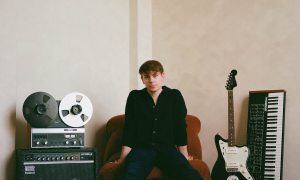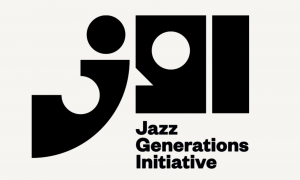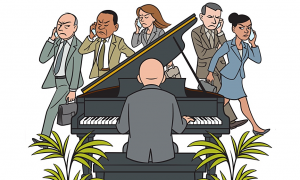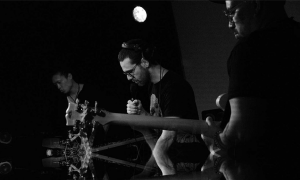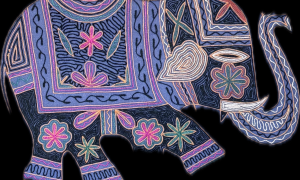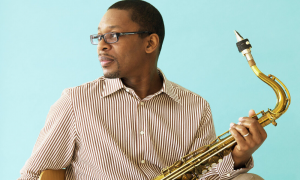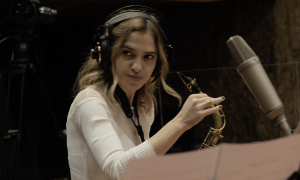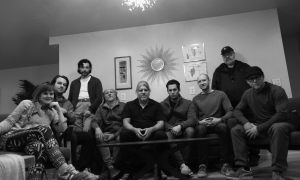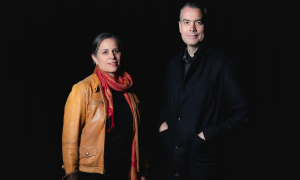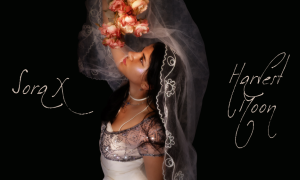Albums by John Coltrane, Eric Dolphy, Herbie Hancock, Wayne Shorter, Horace Silver, and Larry Young Digitally Remastered from Original Analog Masters
New York, NY: Blue Note/EMI is pleased to announce today’s high definition, master-quality audio release of six classics from the label’s legendary catalog on HDtracks. John Coltrane’s Blue Train, Eric Dolphy’s Out To Lunch, Herbie Hancock’s Maiden Voyage, Wayne Shorter’s Speak No Evil, Horace Silver’s Song for My Father, and Larry Young’s Unity have been digitally remastered for the first time in 96kHz/24bit and 192kHz/24bit from their original analog multi-track masters. All of the albums are accompanied by their original sleeve notes plus additional photos and newly-written package essays.
Blue Note president Don Was says, “In preparing these hi def remasters, we were very conscientious about maintaining the feel of the original releases while adding a previously unattainable transparency and depth. It now sounds like you've set up your chaise lounge right in the middle of Rudy Van Gelder's studio!”
Today’s HDtracks debuts, remastered in hi-res by Alan Yoshida and Robin Lynn at Blanche DuBois, follow the recent HDtracks bows of several other EMI albums, including The Beach Boys’ landmark 1966 album Pet Sounds, Norah Jones’ new album, Little Broken Hearts, and Jones’ earlier Blue Note albums: Not Too Late, Feels Like Home, and Come Away With Me.
HDtracks is a high-quality music download service offering a diverse catalog of music from around the world. HDtracks offers both AIFF and FLAC lossless files, and select titles are available in ultra-high resolution 96khz/24bit files, providing audiophiles who demand the highest quality recordings with an online experience not available anywhere else.
In 1957, while in the midst of finding his own voice on the tenor saxophone in bands led by jazz freedom riders Miles Davis and Thelonious Monk, John Coltrane enlisted a band of peers and entered Rudy Van Gelder’s Hackensack, N.J., studio. With a new spirit rising, Coltrane created Blue Train, a 40-minute-plus masterwork that stands as one of the greatest jazz records of all time. It was only Coltrane’s second album as leader, and his sole recording under his own name for Blue Note Records.
Free-flying Eric Dolphy veered into the contrarian zone in his musical approach on his one and only Blue Note album, 1964’s Out To Lunch. Breaking away from the clichés of post-bop jazz and speaking boldly on his array of instruments (flute and alto sax, as well as bass clarinet), Dolphy displayed the avant-garde modus operandi to expect the unexpected. The sometimes abstract and off-kilter yet often whimsical album turned heads and opened ears, and it has gone down in jazz history as one of the genre’s masterpieces. A must-hear. A best bet. A revelation.
1965’s Maiden Voyage sprang from the mind of one of the most adept and creative of the sound-sculpting facilitators, pianist and composer Herbie Hancock. By the time he recorded the album, Hancock had been in the Miles Davis Quintet for several years, an experience he, bassist Ron Carter and drummer Tony Williams (the rhythm section here) all described as transformative. Arguably Hancock’s peak solo statement from the 1960s, Maiden Voyage appropriates elements of the Davis group dynamic for a transfixingly understated meditation on the lure of the sea. The album is also a perfect case study in the art of group interplay; it offers an array of thoughtful answers to the question “How, exactly, does conversation happen in jazz?”
On the spectrum of jazz challenges, Wayne Shorter’s 1965 album Speak No Evil appears to lean toward the easy side. It sits in a comfortable and utterly approachable medium swing. Its primary theme is a series of long tones outlining placid, open-vista harmony. Its bridge resembles something from the notebook of Thelonious Monk – a simple staccato motif that stair-steps up and down, each phrase defined by strategic accents. Yet, as often happens in the music of Wayne Shorter, things are not entirely what they seem. There are layers. The notes of the melody tell one story; the chords nudge the musicians someplace else, a realm where theory lessons are of limited value and instinct matters more than intellect.
Song for My Father stands as the milestone of Horace Silver’s oeuvre, not only for its snappy songs (most originals, no songbook standards), but also for its top-tier ensemble interplay. Silver’s pianism is unmistakable in its percussive bounce, with his light pounce on the keys fashioning chords that contribute to the hard bop rhythm. While he’s not a flashy virtuoso of the instrument, he’s a charismatic craftsman whose mesmerizing songs afford his band mates ample room to improvise with brio. The sessions were recorded a year apart, from October 1963 to October 1964, by two different ensembles (Silver’s old band on two songs, and his then-new quintet on the other four).
If you happened to be a fan of the jazz organ sound in 1965, you knew exactly what to expect when you stepped into a club – greasy blues, ballads and jazz warhorses played at racecar tempos. Larry Young’s Unity changed that. In one elegant stroke. All by itself. Embracing modal harmony and the freer, more open structures/language favored by the rising crew of post-bop musicians, Young expanded commonly held notions of what was possible on the instrument; his brisk, restless, masterfully syncopated performances on this album brought the organ into the modern post-bop conversation.
New York, NY: Blue Note/EMI is pleased to announce today’s high definition, master-quality audio release of six classics from the label’s legendary catalog on HDtracks. John Coltrane’s Blue Train, Eric Dolphy’s Out To Lunch, Herbie Hancock’s Maiden Voyage, Wayne Shorter’s Speak No Evil, Horace Silver’s Song for My Father, and Larry Young’s Unity have been digitally remastered for the first time in 96kHz/24bit and 192kHz/24bit from their original analog multi-track masters. All of the albums are accompanied by their original sleeve notes plus additional photos and newly-written package essays.
Blue Note president Don Was says, “In preparing these hi def remasters, we were very conscientious about maintaining the feel of the original releases while adding a previously unattainable transparency and depth. It now sounds like you've set up your chaise lounge right in the middle of Rudy Van Gelder's studio!”
Today’s HDtracks debuts, remastered in hi-res by Alan Yoshida and Robin Lynn at Blanche DuBois, follow the recent HDtracks bows of several other EMI albums, including The Beach Boys’ landmark 1966 album Pet Sounds, Norah Jones’ new album, Little Broken Hearts, and Jones’ earlier Blue Note albums: Not Too Late, Feels Like Home, and Come Away With Me.
HDtracks is a high-quality music download service offering a diverse catalog of music from around the world. HDtracks offers both AIFF and FLAC lossless files, and select titles are available in ultra-high resolution 96khz/24bit files, providing audiophiles who demand the highest quality recordings with an online experience not available anywhere else.
In 1957, while in the midst of finding his own voice on the tenor saxophone in bands led by jazz freedom riders Miles Davis and Thelonious Monk, John Coltrane enlisted a band of peers and entered Rudy Van Gelder’s Hackensack, N.J., studio. With a new spirit rising, Coltrane created Blue Train, a 40-minute-plus masterwork that stands as one of the greatest jazz records of all time. It was only Coltrane’s second album as leader, and his sole recording under his own name for Blue Note Records.
Free-flying Eric Dolphy veered into the contrarian zone in his musical approach on his one and only Blue Note album, 1964’s Out To Lunch. Breaking away from the clichés of post-bop jazz and speaking boldly on his array of instruments (flute and alto sax, as well as bass clarinet), Dolphy displayed the avant-garde modus operandi to expect the unexpected. The sometimes abstract and off-kilter yet often whimsical album turned heads and opened ears, and it has gone down in jazz history as one of the genre’s masterpieces. A must-hear. A best bet. A revelation.
1965’s Maiden Voyage sprang from the mind of one of the most adept and creative of the sound-sculpting facilitators, pianist and composer Herbie Hancock. By the time he recorded the album, Hancock had been in the Miles Davis Quintet for several years, an experience he, bassist Ron Carter and drummer Tony Williams (the rhythm section here) all described as transformative. Arguably Hancock’s peak solo statement from the 1960s, Maiden Voyage appropriates elements of the Davis group dynamic for a transfixingly understated meditation on the lure of the sea. The album is also a perfect case study in the art of group interplay; it offers an array of thoughtful answers to the question “How, exactly, does conversation happen in jazz?”
On the spectrum of jazz challenges, Wayne Shorter’s 1965 album Speak No Evil appears to lean toward the easy side. It sits in a comfortable and utterly approachable medium swing. Its primary theme is a series of long tones outlining placid, open-vista harmony. Its bridge resembles something from the notebook of Thelonious Monk – a simple staccato motif that stair-steps up and down, each phrase defined by strategic accents. Yet, as often happens in the music of Wayne Shorter, things are not entirely what they seem. There are layers. The notes of the melody tell one story; the chords nudge the musicians someplace else, a realm where theory lessons are of limited value and instinct matters more than intellect.
Song for My Father stands as the milestone of Horace Silver’s oeuvre, not only for its snappy songs (most originals, no songbook standards), but also for its top-tier ensemble interplay. Silver’s pianism is unmistakable in its percussive bounce, with his light pounce on the keys fashioning chords that contribute to the hard bop rhythm. While he’s not a flashy virtuoso of the instrument, he’s a charismatic craftsman whose mesmerizing songs afford his band mates ample room to improvise with brio. The sessions were recorded a year apart, from October 1963 to October 1964, by two different ensembles (Silver’s old band on two songs, and his then-new quintet on the other four).
If you happened to be a fan of the jazz organ sound in 1965, you knew exactly what to expect when you stepped into a club – greasy blues, ballads and jazz warhorses played at racecar tempos. Larry Young’s Unity changed that. In one elegant stroke. All by itself. Embracing modal harmony and the freer, more open structures/language favored by the rising crew of post-bop musicians, Young expanded commonly held notions of what was possible on the instrument; his brisk, restless, masterfully syncopated performances on this album brought the organ into the modern post-bop conversation.













